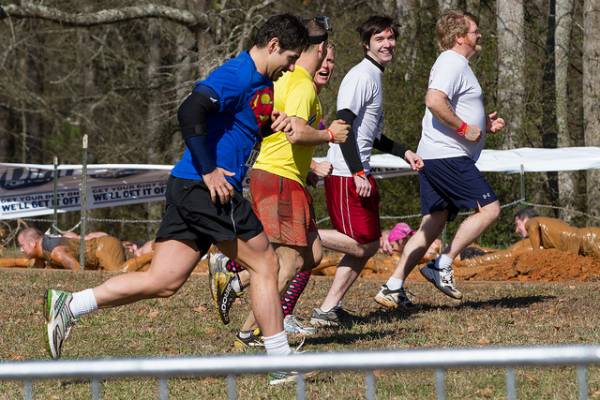Obstacle course racing (OCR) is growing in popularity year-on-year. With this growth in participation comes an increase in the number of people training specifically for OCR events. However, I often see three big mistakes when it comes to their training. Let’s look at what these errors are and how to avoid them.
Obstacle course racing (OCR) is growing in popularity year-on-year. With this growth in participation comes an increase in the number of people training specifically for OCR events. However, I often see three big mistakes when it comes to their training. Let’s look at what these errors are and how to avoid them.
The 3 Biggest OCR Training Mistakes
The three biggest holes I notice in OCR training boil down to running, loaded carries, and grip training. These issues are also right up there in terms of mistakes that cost people the most time on race day.
1. Running
The first and worst mistake you can make is to forget it’s a running race. Don’t look at all the obstacles and think you only have to run half a mile between each and think to yourself, “well, I can run 800m, so this will be easy.” Because if you plan to do well, you still need to run the entire course, which could be as much as half marathon distance (13.1 miles.)
2. Loaded Carries
At the World Championships held on the weekend, the guys doing the crazy Ultra Beast (30 miles of torture) had to carry two 50lb sandbags uphill. I’ve heard it was absolute carnage with people just dropping the bags and walking off the course. I’ve heard accounts of up to 25% of the field quitting because of that one obstacle.
But it’s not just sandbag carries, either. There are often bucket carries at Spartan events – in fact, it’s one of the obstacles you’ll find at nearly all the races. In Australia they use massive 120lb deadballs, which are difficult to pick up with wet, muddy hands, and even more difficult to carry the distance required.
3. Grip Work
The third mistake, grip strength, is one of those things that everyone seems to think they have enough of, right up until the point they find themselves doing thirty burpees for falling off the monkey bars. In a long race, with rope climbs, Tyrolean traverses, Hercules hoists, loaded carries, and heavy drags your grip takes a pounding. And the fatigue of distance running amplifies how easily fatigued your grip will become.
Here’s how I recommend you train each of these areas to prepare for race day.
Running
Firstly, you need to run. If you aren’t yet at the stage where you can run the distance non-stop, you need to work on that before you worry about how fast you can cover the distance. If you’re using an obstacle race to get up off the couch (the precise reason Joe de Sena founded Spartan in the first place) then please follow my walk/run plan to get started.
If you’re able to run the distance continuously, I’d suggest a plan that has four different runs plus an extra day in it. The four runs are:
- Easy aerobic
- Intervals
- Hills
- Long run
The extra day is for sandbag or pack work, but done walking. The week should be structured with the long run (up to two hours) on Saturday, with the sandbag or pack work done on the following day. Don’t be shy with the time for the pack day – go up to four hours.
Your legs will be tired after both of these days, so the next run will be Tuesday and be an easy aerobic run up to an hour in length. Don’t push the pace on this run, and don’t worry about hills – just an easy, flat run to shake the legs out.
The interval run is best done on a track. Something like 20 x 400m on a three-minute-interval will work well. Or 10 x 800m on six minutes. Make sure to warm up and cool down for this one as it will lead to some serious soreness, so give your body the best chance to fight it off.

Finally, the hill run fits well on a Thursday. I like doing this on a treadmill so I can moderate the incline. My favorite hill session is five sets of 1km above race pace at 4-5%, followed by 1km below race pace on flat so you can recover. The average of these 2km is your target race pace. Again, make sure to warm up and cool down before this, and don’t be fooled by this as it is still at least a 12km run.
Loaded Carries
Loaded carries need to be in every training session. If you’re not used to doing them you need to spend considerable time on them to gain proficiency at it. As an example of how efficient you can get at them, I recently had eight minutes to get off an airplane, get to the long-term car park, and then to the pet hotel my dog was at before they shut for the night. I grabbed both my carry-on bag and my girlfriend’s bag (it is easier to be balanced) and took off running through the airport, to the car park, and to the car. This was a ten-minute walk done in three minutes.
Now, I won’t lie, I was spent – my grip was fried, my traps were burning, and my lungs were heaving. But I got it done and we picked up our dog. If you plan to be truly Spartan -ready you will need to build up to loaded running (but that’s probably an entire article right there).
Don’t make the mistake of only doing farmer’s walks with easy-to-handle implements. Use overhead walks, rack walks, and sandbag carries. Load yourself asymmetrically and use odd objects. For Spartan you need to be ready for anything.
Grip Training
Finally, grip needs to be addressed. Some grip endurance will be handled with the loaded carries. Some more grip endurance will be taken care of with normal strength work, such as pull-ups and deadlifts. But what you need is high rep work to develop massive amounts of grip endurance – enough to last you the many hours you may be on course. A short set of ten reps isn’t going to do it.
This is a great place for two different types of grip work. High rep swings, both with a kettlebell and with clubbells, will help develop great grip endurance. I’m talking about sets of twenty-plus reps, and maybe even as high as fifty per set. Because clubbells are closer to brachiation than kettlebells are, they may actually be superior for grip development.
The other big thing that is going to develop grip endurance is hanging off objects. If you can vary the grip used, that will work even better. If you can hang off tree branches, stair railings, and the like you’ll wind up with a far better overall grip.

If all you have access to is a pull up bar don’t fret, as you can still change the grip each set. You can fold a towel over the bar to thicken the grip. You can drape the towel over the bar and hold onto the hanging ends. You can hold the bar with hands you’ve deliberately made slippery (putting soap in the hands is a favored strongman grip training method) and do hangs. For more fun, soap the hands and then do some kettlebell swings. Make sure no one is standing right in front of you when you do though.
Focusing on these three things – running, grip, and carries – will take care of your OCR plan.
Photo 1″Mountain Creek Super Spartan Race” by Senorjerome Attribution-NonCommercial License.
Photo 2 “IMG_9816” by John Ramspott Attribution-NonCommercial License.
Photo 3 courtesy of Shutterstock.






